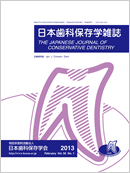Volume 51, Issue 2
Displaying 1-11 of 11 articles from this issue
- |<
- <
- 1
- >
- >|
Original Articles
-
Article type: Original Articles
2008 Volume 51 Issue 2 Pages 123-129
Published: April 30, 2008
Released on J-STAGE: March 31, 2018
Download PDF (1285K) -
Article type: Original Articles
2008 Volume 51 Issue 2 Pages 130-137
Published: April 30, 2008
Released on J-STAGE: March 31, 2018
Download PDF (1649K) -
Article type: Original Articles
2008 Volume 51 Issue 2 Pages 138-146
Published: April 30, 2008
Released on J-STAGE: March 31, 2018
Download PDF (1095K) -
Article type: Original Articles
2008 Volume 51 Issue 2 Pages 147-155
Published: April 30, 2008
Released on J-STAGE: March 31, 2018
Download PDF (1045K) -
Article type: Original Articles
2008 Volume 51 Issue 2 Pages 156-162
Published: April 30, 2008
Released on J-STAGE: March 31, 2018
Download PDF (1314K) -
Article type: Original Articles
2008 Volume 51 Issue 2 Pages 163-168
Published: April 30, 2008
Released on J-STAGE: March 31, 2018
Download PDF (777K) -
Article type: Original Articles
2008 Volume 51 Issue 2 Pages 169-176
Published: April 30, 2008
Released on J-STAGE: March 31, 2018
Download PDF (970K) -
Article type: Original Articles
2008 Volume 51 Issue 2 Pages 177-190
Published: April 30, 2008
Released on J-STAGE: March 31, 2018
Download PDF (1628K) -
Article type: Original Articles
2008 Volume 51 Issue 2 Pages 191-202
Published: April 30, 2008
Released on J-STAGE: March 31, 2018
Download PDF (1807K) -
Article type: Original Articles
2008 Volume 51 Issue 2 Pages 203-209
Published: April 30, 2008
Released on J-STAGE: March 31, 2018
Download PDF (845K) -
Article type: Original Articles
2008 Volume 51 Issue 2 Pages 210-217
Published: April 30, 2008
Released on J-STAGE: March 31, 2018
Download PDF (1724K)
- |<
- <
- 1
- >
- >|
